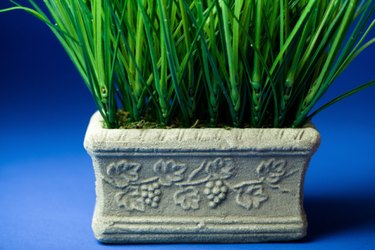Things You'll Need
Small rocks
Fertilizer
Tomato cages

When you're faced with very little space for vegetable, herb or flower gardens, you may have wondered how to set up a planter box garden. Planter boxes come in a wide variety of sizes and shapes, although the most commonly seen is a square or rectangular container. A balcony, windowsill or even a front porch can become a potential location for your gardening efforts. Better still, using planter boxes deters weeds and avoids several soil-related issues, like diseases and insects.
Step 1
Select the location for your planter box. Think about the type of vegetation going in the container in making this choice. Leafy vegetables and root vegetable don't mind partial shade, whereas fruits, fruiting vegetables and flowers do better when they receive at least five hours of sun daily.
Video of the Day
Step 2
Purchase a container. The base material for planters varies, but wood is a popular choice. Note that when growing food crops in planter boxes, you should avoid pressure treated wood -- the chemicals in the container can leach into your soil and into your edibles.
Step 3
Obtain potting soil and your chosen fruits, vegetables or flowers at a nearby nursery. Dwarf varieties suit box gardening ideally, as they take up less space. Check the plants for signs of disease or insect infestation. Get the healthiest vegetation possible.
Step 4
Set up the planter box in the chosen location before you fill it. Once full, these get very heavy. Add some small rocks to the bottom of the box for good drainage. Pour the potting soil evenly over the top of the stones so it reaches within ½ inch of the container's top.
Step 5
Sow your vegetation into the container just as you would in a regular garden. Follow the directions on the seed pack or seedling label. If two plants look nearly identical make sure to label them. Water the soil lightly. Don't soak it.
Step 6
Tend the box adding water, fertilizer and supports like tomato cages as needed. Container gardens dry out fairly quickly, particularly those in sunny locations. Adjust the spacing on seedlings once they have thee leaves showing.
Tip
A 1 1/2-gallon box container can house cherry tomatoes, spinach or romaine. A 3-gallon box suits carrots, sweet or hot peppers, and leaf lettuce.
Warning
Avoid overfertilizing. Wait 8-10 weeks for the first application and then add more according to the manufacturer's directions, every two weeks.
Video of the Day
- University of Florida Extension: Minigardening
- Arizona University Cooperative Extension: Vegetable Garden - Container Garden
- Middle Township: Planter Box
- Purdue University Extension: Container and Raised Bed Gardening
- University of Illinois Extension: Successful Container Gardens
- Texas A&M University Extension: Vegetable Gardening In Containers